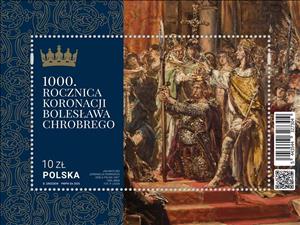Souvenir Sheet: Coronation of King Bolesław the Brave, 1000 Years (Poland 2025)
Coronation of King Bolesław the Brave, 1000 Years (Poland 2025)
18 April (Poland ) within release Coronation of King Bolesław the Brave, 1000 Years goes into circulation Souvenir Sheet Coronation of King Bolesław the Brave, 1000 Years face value 10 Polish złoty
| Souvenir Sheet Coronation of King Bolesław the Brave, 1000 Years in catalogues | |
|---|---|
| Colnect codes: | Col: PL 2025.04.18-01 |
Souvenir Sheet is horizontal format.
Also in the issue Coronation of King Bolesław the Brave, 1000 Years:
- Souvenir Sheet - Coronation of King Bolesław the Brave, 1000 Years face value 10;
- Stamp - Coronation of King Bolesław the Brave, 1000 Years face value 10;
Souvenir Sheet Coronation of King Bolesław the Brave, 1000 Years it reflects the thematic directions:
Art is a diverse range of human activities in creating visual, auditory or performing artifacts (artworks), expressing the author's imaginative or technical skill, intended to be appreciated for their beauty or emotional power. In their most general form these activities include the production of works of art, the criticism of art, the study of the history of art, and the aesthetic dissemination of art. The oldest documented forms of art are visual arts, which include creation of images or objects in fields including painting, sculpture, printmaking, photography, and other visual media. Architecture is often included as one of the visual arts; however, like the decorative arts, or advertising, it involves the creation of objects where the practical considerations of use are essential—in a way that they usually are not in a painting, for example. Music, theatre, film, dance, and other performing arts, as well as literature and other media such as interactive media, are included in a broader definition of art or the arts. Until the 17th century, art referred to any skill or mastery and was not differentiated from crafts or sciences. In modern usage after the 17th century, where aesthetic considerations are paramount, the fine arts are separated and distinguished from acquired skills in general, such as the decorative or applied arts.
King is the title given to a male monarch in a variety of contexts. The female equivalent is queen regnant (while the title of queen on its own usually refers to the consort of a king). In the context of prehistory, antiquity and contemporary indigenous peoples, the title may refer to tribal kingship. Germanic kingship is cognate with Indo-European traditions of tribal rulership (c.f. Indic rājan, Gothic reiks, and Old Irish rí, etc.) In the context of classical antiquity, king may translate Latin rex or either Greek archon or basileus. In classical European feudalism, the title of king as the ruler of a kingdom is understood as the highest rank in the feudal order, potentially subject, at least nominally, only to an emperor (harking back to the client kings of the Roman Empire). In a modern context, the title may refer to the ruler of one of a number of modern monarchies (either absolute or constitutional). The title of king is used alongside other titles for monarchs, in the West prince, emperor, archduke, duke or grand duke, in the Middle East sultan or emir; etc. Kings, like other royalty, tend to wear purple because purple was an expensive color to wear in the past.


